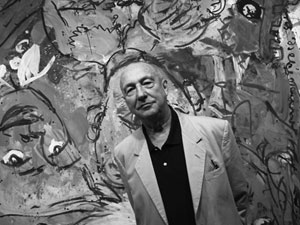
Wilhelm Heinrich Otto Dix was a German painter and printmaker, noted for his ruthless and harshly realistic depictions of German society during the Weimar Republic and the brutality of war. Along with George Grosz and Max Beckmann, he is widely considered one of the most important artists of the Neue Sachlichkeit.

Georg Baselitz is a German painter, sculptor and graphic artist. In the 1960s he became well known for his figurative, expressive paintings. In 1969 he began painting his subjects upside down in an effort to overcome the representational, content-driven character of his earlier work and stress the artifice of painting. Drawing from myriad influences, including art of Soviet era illustration art, the Mannerist period and African sculptures, he developed his own, distinct artistic language.

Abraham Bloemaert was a Dutch painter and printmaker who used etching and engraving. He initially worked in the style of the "Haarlem Mannerists", but by the beginning of the 17th-century altered his style in line with the new Baroque style that was then developing. He mostly painted history subjects and some landscapes. He was an important teacher, who trained most of the Utrecht Caravaggisti.

Jan Lievens was a Dutch Golden Age painter who was associated with his close contemporary Rembrandt, a year older, in the early parts of their careers. They shared a birthplace in Leiden, training with Pieter Lastman in Amsterdam, where they shared a studio for about five years until 1631. Like Rembrandt he painted both portraits and history paintings, but unlike him Lievens' career took him away from Amsterdam to London, Antwerp, The Hague and Berlin.

Cornelis de Vos was a Flemish painter, draughtsman and art dealer. He was one of the leading portrait painters in Antwerp and is best known for his sensitive portraits, in particular of children and families. He was also successful in other genres including history, religious and genre painting. He was a regular collaborator with Rubens.

Lotte Laserstein was a German-Swedish painter. She was an artist of figurative paintings in Germany's Weimar Republic. The National Socialist regime and its anti-Semitism forced her to leave Germany in 1937 and to emigrate to Sweden. In Sweden, she continued to work as a portraitist and painter of landscapes until her death. The paintings she created during the 1920s and 1930s fit into the movement of New Objectivity in Germany.
Jan Ruhtenberg was an architect who "made significant contributions in introducing modern architecture to the United States as a teacher and a modern architect".

Susan Charna Rothenberg was an American contemporary painter, printmaker, sculptor, and draughtswoman. She became known as an artist through her iconic images of the horse, which synthesized the opposing forces of abstraction and representation.

Jan Grzegorz Stanisławski was a Polish modernist painter, art educator, and founder and member of various innovative art groups and literary societies. In 1906 he became a full professor at the Academy of Fine Arts in Kraków.
Svetlana Leontief Alpers is an American art historian, also a professor, writer and critic. Her specialty is Dutch Golden Age painting, a field she revolutionized with her 1984 book The Art of Describing. She has also written on Tiepolo, Rubens, Bruegel, and Velázquez, among others.
Marilyn Kirsch is an American artist, known for abstract and non-objective paintings often described as Lyrical Abstraction.
R. H. Quaytman is an American contemporary artist, best known for paintings on wood panels, using abstract and photographic elements in site-specific "Chapters", now numbering 35. Each chapter is guided by architectural, historical and social characteristics of the original site. Since 2008, her work has been collected by a number of modern art museums. She is also an educator and author based in Connecticut.

Berta Golahny was an American painter, printmaker, and sculptor.
Jane Stuart was an American painter, best known for her miniature paintings and portraits, particularly those made of George Washington. She worked on and later copied portraits made by her father, Gilbert Stuart, and created her own portraits. In the early 19th century, she assumed the responsibility of supporting her family after her father's death. She first worked in Boston, but later moved to Newport, Rhode Island, where she was the first woman who painted portraits. In 2011, she was inducted into the Rhode Island Heritage Hall of Fame.

Elizabeth Wentworth Roberts was an American painter who lived and worked in Philadelphia, Pennsylvania, Paris, and Concord, Massachusetts. She established the Jennie Sesnan Gold Medal at the Pennsylvania Academy of the Fine Arts, where she had studied and won the Mary Smith Prize. She also studied in Paris at Académie Julian and Florence. In Massachusetts, Roberts founded and funded the Concord Art Association.

Gretchen Woodman Rogers (1881–1967) was an American painter associated with the Boston School.
Constance Coleman Richardson (1905–2002) was an American painter best known for her American Scene landscapes and interplay of light on figures, evocative of Edward Hopper. She attended Vassar College and Pennsylvania Academy of the Fine Arts and was married to art historian and museum director Edgar Preston Richardson from 1931 until his death in 1985.

Ynez Johnston was an American painter, sculptor, printmaker, and educator. Known for her work in painting, printmaking, and mixed media, Johnston was particularly inspired by Byzantine art, as well as Tibetan, Indian, Mexican, and Nepalese art from her extensive travels. Johnston was based in the San Francisco Bay Area in early life, and moved to Los Angeles in 1949.
Ann Pibal is an American painter who makes geometric compositions using acrylic paint on aluminum panel. The geometric intensity is one of the key characteristics that defines her paintings.

Cornelia Schleime is a German painter, performer, filmmaker and author. Born in East Berlin under the GDR, she studied painting and graphic arts at the Dresden Academy of Fine Arts before becoming a member of the underground art scene.













